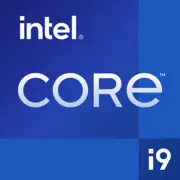Intel Core i9-12950HX

Intel Core i9-12950HX in 2025: Is It Worth Buying a Laptop with This Processor?
An analysis of performance, battery life, and relevance of the hybrid chip for gaming and work.
Architecture and Technology Process: A Hybrid Approach for Balance
The Intel Core i9-12950HX processor, released in 2022, is built on a hybrid Alder Lake architecture (Intel 7 process, 10 nm Enhanced SuperFin). Its key feature is the division of cores into Performance-cores (P-cores) and Efficient-cores (E-cores):
- 16 cores (8 P-cores + 8 E-cores) and 24 threads (P-cores support Hyper-Threading).
- P-cores operate at frequencies up to 5.00 GHz in turbo mode, handling resource-intensive tasks.
- E-cores are optimized for background processes with frequencies up to 3.60 GHz, reducing overall power consumption.
- 30 MB of L3 cache accelerates data processing, and support for DDR5-4800 and PCIe 5.0 provides high bandwidth.
Integrated Intel UHD Graphics for 12th Gen (32 EU, up to 1.45 GHz) is suitable for basic tasks: office applications, 4K video, light gaming (e.g., CS:GO at low settings). However, for AAA games or 3D modeling, a discrete graphics card (e.g., RTX 4070 or higher) is required.
Power Consumption and TDP: Balancing Power and Heat
The nominal TDP of the processor is 55 W, but in turbo mode, power consumption can reach 157 W. This necessitates strong cooling systems:
- Laptops with the i9-12950HX are equipped with massive heat sinks and 2-3 fans (e.g., MSI GT77 Titan).
- Without adequate cooling, P-core frequency drops to 4.2–4.5 GHz under sustained load.
- For comparison: competitors in 2025, such as AMD Ryzen 9 7945HX (Zen 4, 5.4 GHz), demonstrate a more stable thermal profile at similar TDP levels.
Performance: From Excel to Cyberpunk 2077
Geekbench 6:
- 2349 points (Single-Core) — comparable to Apple M2 Pro (2350), but lower than Ryzen 9 7945HX (2480).
- 12701 points (Multi-Core) — surpasses M2 Max (~11500), but lags behind Ryzen 9 7945HX (~13500).
Real-World Scenarios:
- Office Tasks (Chrome, Excel): 20+ tabs + chart rendering — no lags.
- Video Editing (Premiere Pro): 4K video rendering in 8–10 minutes (compared to 6–7 minutes with Ryzen 9 7945HX).
- Gaming (with RTX 4080): Cyberpunk 2077 (Ultra, RT On) — 75–80 FPS at FullHD. In turbo mode, the FPS increase does not exceed 5–7%, but CPU temperature reaches 95°C.
Turbo Mode: Maximum frequency is maintained for 15–20 seconds, after which the system balances between performance and heat.
Use Cases: Who is the i9-12950HX Suitable For?
1. Professionals:
- Video editors, 3D designers, programmers (code compilation).
- Example: rendering in Blender is 20% faster than with i7-12700H.
2. Gamers:
- Streaming + gaming without FPS drops (thanks to 24 threads).
3. Everyday Tasks:
- Excessive for web browsing, but the "power reserve" will extend the laptop's relevance for 3–4 years.
Battery Life: The Cost of Performance
During intensive use (gaming, rendering), the laptop runs on battery for 1.5–2 hours. In power-saving mode (office tasks, 50% brightness):
- 5–6 hours (compared to 8–10 hours with Ryzen 9 7940HS).
Energy-saving Technologies:
- Intel Dynamic Tuning 2.0 — automatically adjusts power based on load.
- Adaptix — driver optimization for reducing iGPU power consumption.
Comparison with Competitors: Intel vs AMD vs Apple
- AMD Ryzen 9 7945HX (Zen 4):
- Better in multi-threaded tasks (+10%), higher IPC, but more expensive (laptops starting at $2200).
- Apple M3 Max:
- Battery life up to 12 hours, but limited compatibility with Windows applications.
- Intel Core i9-13980HX (Raptor Lake):
- 15% increase in gaming performance, but laptops start at $2500.
Conclusion: In 2025, the i9-12950HX is a choice for those seeking a powerful laptop in the $1500–$1800 range (e.g., Lenovo Legion Pro 7i or ASUS ROG Strix Scar 17).
Pros and Cons
Strengths:
- Record multi-threaded performance.
- Support for DDR5 and PCIe 5.0 (relevant for NVMe SSDs at 7000 MB/s).
- Optimization for Windows 11 (task distribution between P- and E-cores).
Weaknesses:
- High heat output under load.
- Short battery life.
- Integrated GPU is weak for modern gaming.
Laptop Selection Recommendations
1. Type of Device:
- Gaming laptops (MSI Raider, ASUS ROG): Discrete graphics (RTX 4070+), 144+ Hz display are mandatory.
- Workstations (Dell Precision, HP ZBook): 64+ GB RAM, 2+ NVMe slots.
2. What to Look For:
- Cooling System: At least 4 heat pipes and fans with dust-proof coating.
- Battery: 90+ Wh for mobility.
- Ports: Thunderbolt 4 for connecting external GPUs or 8K monitors.
Final Verdict
The Intel Core i9-12950HX in 2025 is a solid choice for:
- Gamers looking to play on ultra settings without upgrading for 3–4 years.
- Professionals needing a mobile workstation for rendering and compilation.
- Enthusiasts willing to tolerate heat for high performance.
Alternatives: If battery life is critical, consider AMD Ryzen 9 7940HS or the Apple MacBook Pro 16″ (M3). If budget is not a concern, opt for laptops with Intel Core i9-13980HX.
Prices in March 2025:
- Laptops with i9-12950HX: from $1500 (ASUS TUF Dash F15) to $2200 (MSI Raider GE78).
- Analogues with Ryzen 9 7945HX: from $2000.
Basic
CPU Specifications
Memory Specifications
GPU Specifications
Miscellaneous
Benchmarks
Compared to Other CPU
Share in social media
Or Link To Us
<a href="https://cputronic.com/cpu/intel-core-i9-12950hx" target="_blank">Intel Core i9-12950HX</a>